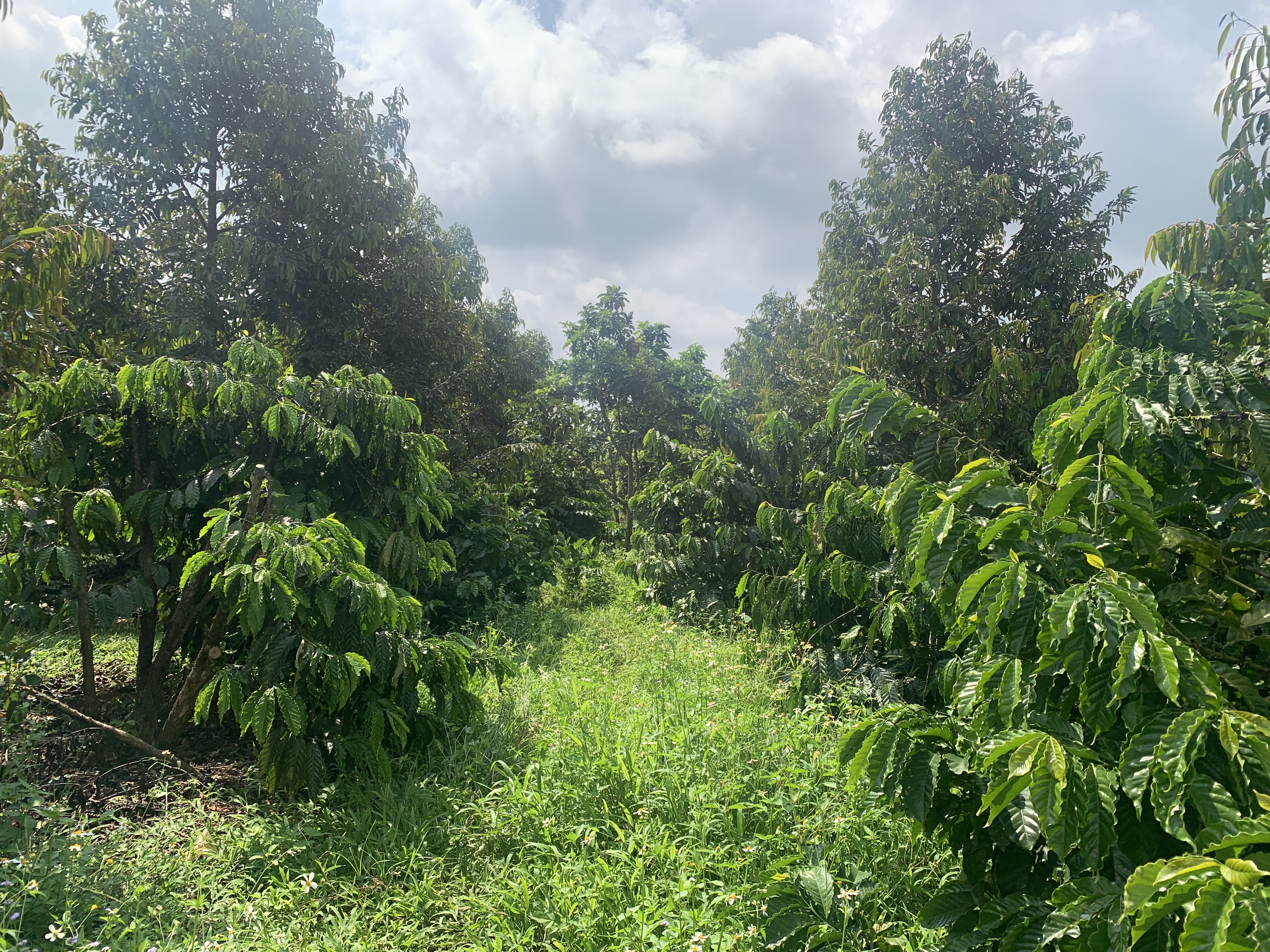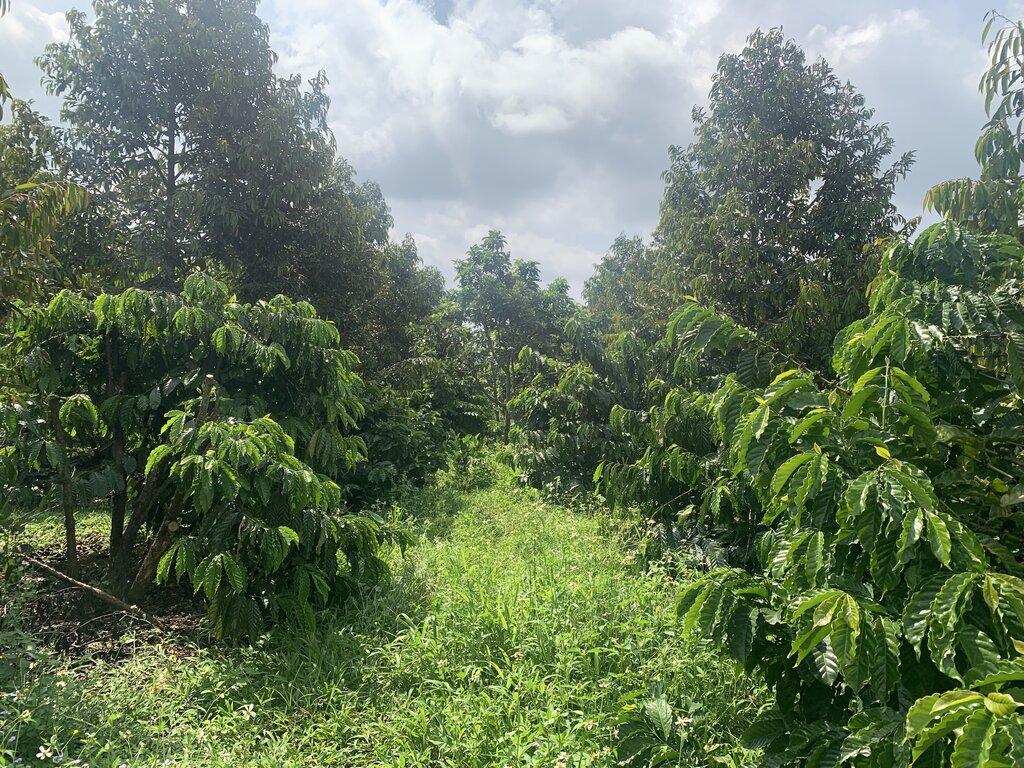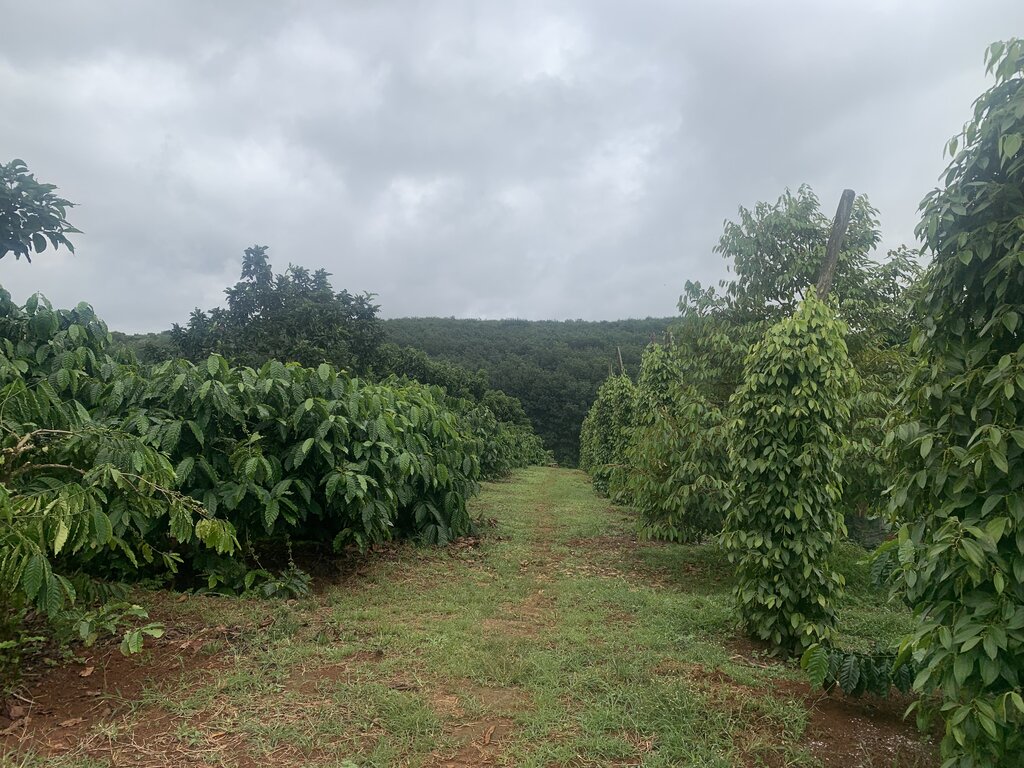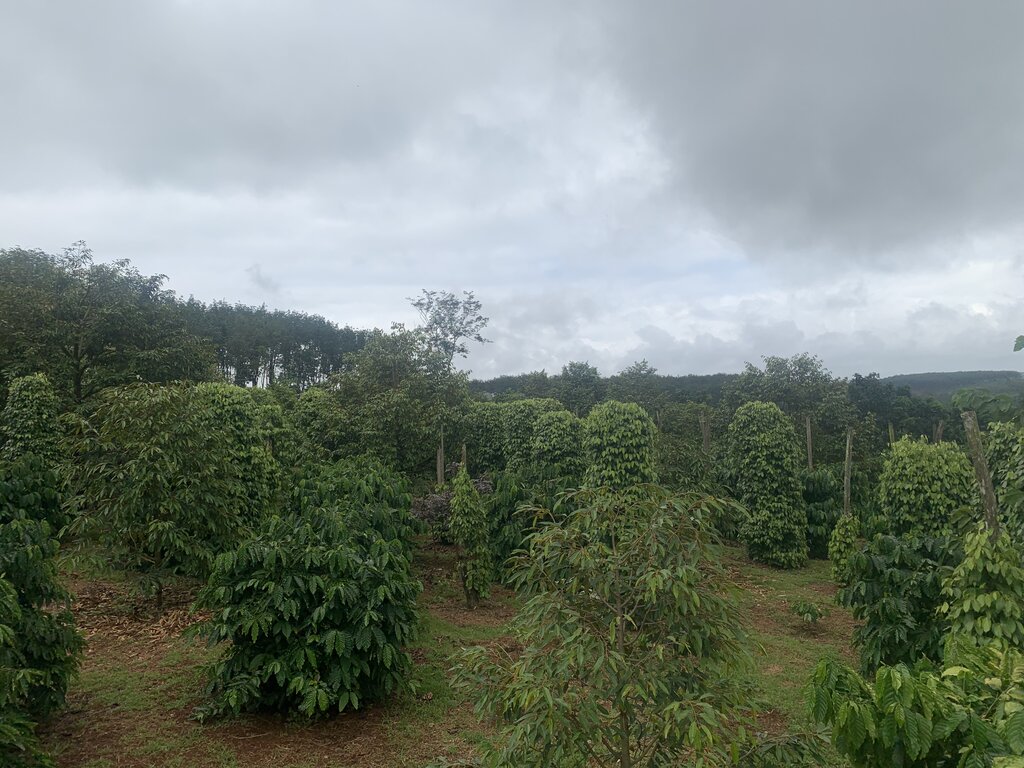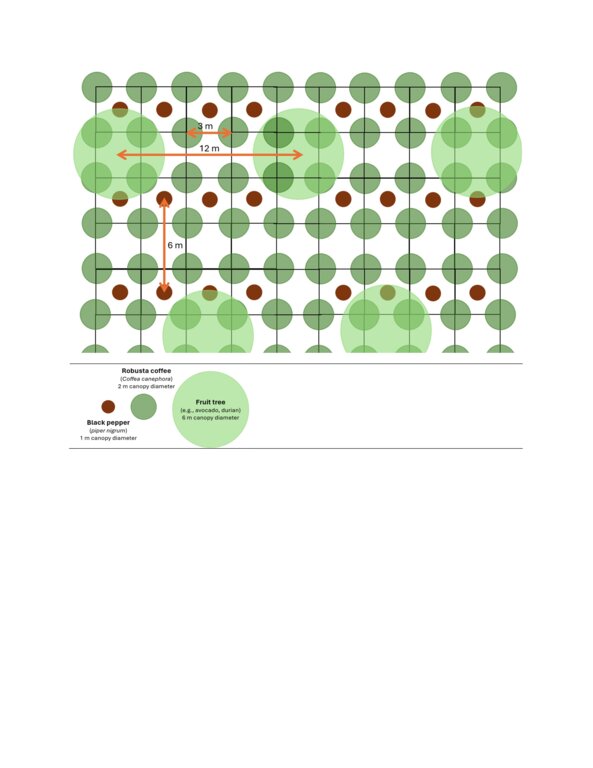Multi-storey intercropping with coffee and fruit trees [เวียดนาม]
- ผู้สร้างสรรค์:
- การอัพเดท:
- ผู้รวบรวม: Carlos Gil Picon
- ผู้เรียบเรียง: Eric Rahn
- ผู้ตรวจสอบ: William Critchley, Rima Mekdaschi Studer
Mô hình trồng xen cây ăn quả trong vườn cà phê
technologies_7387 - เวียดนาม
ดูส่วนย่อย
ขยายทั้งหมด ย่อทั้งหมด1. ข้อมูลทั่วไป
1.2 รายละเอียดที่ติดต่อได้ของผู้รวบรวมและองค์กรที่เกี่ยวข้องในการประเมินและการจัดเตรียมทำเอกสารของเทคโนโลยี
วิทยากรหลัก
co-compiler:
Ha Tuan
Nguyen University and CIAT
เวียดนาม
ชื่อของโครงการซึ่งอำนวยความสะดวกในการทำเอกสารหรือการประเมินเทคโนโลยี (ถ้าเกี่ยวข้อง)
Land Use Based Mitigation for Resilient Climate Pathways (LANDMARC)ชื่อขององค์กรซึ่งอำนวยความสะดวกในการทำเอกสารหรือการประเมินเทคโนโลยี (ถ้าเกี่ยวข้อง)
Alliance Bioversity and International Center for Tropical Agriculture -Vietnam (Alliance Bioversity-CIAT)1.3 เงื่อนไขการใช้ข้อมูลที่ได้บันทึกผ่านทาง WOCAT
ผู้รวบรวมและวิทยากรหลักยอมรับเงื่อนไขเกี่ยวกับการใช้ข้อมูลที่ถูกบันทึกผ่านทาง WOCAT:
ใช่
1.4 การเปิดเผยเรื่องความยั่งยืนของเทคโนโลยีที่ได้อธิบายไว้
เทคโนโลยีที่ได้อธิบายไว้นี้เป็นปัญหาของความเสื่อมโทรมโทรมของที่ดินหรือไม่ จึงไม่ได้รับการยอมรับว่าเป็นเทคโนโลยีเพื่อการจัดการที่ดินอย่างยั่งยืน:
ไม่ใช่
2. การอธิบายลักษณะของเทคโนโลยี SLM
2.1 การอธิบายแบบสั้น ๆ ของเทคโนโลยี
คำจำกัดความของเทคโนโลยี:
Robusta coffee in the Central Highlands of Vietnam is intercropped with pepper vines and fruit trees thus increasing the total planting density. This leads to higher land equivalent ratios compared to monocropping, thereby increasing land use efficiency, profitability, soil protection and resilience.
2.2 การอธิบายแบบละเอียดของเทคโนโลยี
คำอธิบาย:
Robusta coffee in the Central Highlands of Vietnam is intercropped with pepper vines and fruit trees, increasing the total planting density. This leads to higher land equivalent ratios (LER) compared to monocropping, thereby increasing land use efficiency, profitability and resilience. The increased plot-level biomass stock also confers better soil protection, and more biomass is returned to the soil through prunings and natural litter formation.
There are a variety of multi-storey intercropping designs based on coffee (Coffea canephora), black pepper (Piper nigrum), avocado (Persea americana), durian (Durio zibethinus) and macadamia (Macadamia integrifolia). An example of a recommended intercropping design is coffee with pepper vines (supported by living poles of Ceiba pentandra, Cassia siamea, Paulownia spp. etc) and fruit trees at densities of 887 coffee bushes, 336 pepper vines, 28 avocado trees and 28 durian trees per hectare (D’Haeze 2022; Rigal et al. 2023). Agronomic practices such as irrigation and nutrient management need to be adapted to this system. For example, water demand by coffee in the shade of fruit trees is less than in monocropping systems. Other practices can be combined, such as the use of cover crops (e.g., Crotalaria) planted between the other crops to avoid bare land.
This technology is increasingly applied in Dak Lak, Gia Lai, Lam Dong and Dak Nong in the Central Highlands of Vietnam, primarily by the Kinh farmers, while ethnic minorities currently rely more frequently on monocropped coffee systems.
The main purpose of this diversified mixed cropping system it to increase land use efficiency as well as productive, climatic and economic resilience. Price volatility is a huge challenge for farmers, particularly with perennial cropping systems where crop changes as response to economic signals is costly and risky due to time-lag effects.
Quality planting material (e.g., use of scion avocado cultivar 034 for grafting), water-saving irrigation systems, and organic and mineral fertilizers are required alongside a careful planting design that minimizes potential competition between associated crops. For example, the Ministry of Agriculture and Rural Development (MARD) provides guidelines (Decision No. 3702, 2018) for designing intercropping systems based on coffee.
The main benefit is economic resilience to volatile prices of perennial commodity crops. Given that perennial crops cannot be easily substituted with other crops that have better prices, diversification of cropping systems is key to economic resilience. Furthermore, land use efficiency is increased and thereby more crops can be produced using less area. Tree-level yields remain the same as in monocropping systems, however, after certain years of fruit tree growth (e.g., avocado) there is a potential of coffee tree-level yield decline due to shade effects. It also helps to manage production costs when crops need to be rejuvenated or replanted. Furthermore, carbon stocks in aboveground biomass are increased compared to monocropping systems. This increase in aboveground carbon stocks leads to higher biomass input to the soil due to fresh litter (prunings) and senescent litter (natural).
Land users choose this intercropping model to diversify their income on the same unit of land. This reduces the risks associated with unpredictable price fluctuations. They also note that this system improves resource use efficiency, requiring less fertilizers and irrigation compared to the monocropping systems.
2.3 รูปภาพของเทคโนโลยี
2.5 ประเทศภูมิภาค หรือสถานที่ตั้งที่เทคโนโลยีได้นำไปใช้และได้รับการครอบคลุมโดยการประเมินนี้
ประเทศ:
เวียดนาม
ภูมิภาค/รัฐ/จังหวัด:
Dak Nong
ข้อมูลจำเพาะเพิ่มเติมของสถานที่ตั้ง :
Hung Binh commune
ระบุการกระจายตัวของเทคโนโลยี:
- กระจายไปอย่างสม่ำเสมอในพื้นที่
If precise area is not known, indicate approximate area covered:
- 100-1,000 ตร.กม.
Is/are the technology site(s) located in a permanently protected area?
ไม่ใช่
Map
×2.6 วันที่การดำเนินการ
ถ้าไม่รู้ปีที่แน่นอน ให้ระบุวันที่โดยประมาณ:
- 10-50 ปี
2.7 คำแนะนำของเทคโนโลยี
ให้ระบุว่าเทคโนโลยีถูกแนะนำเข้ามาอย่างไร:
- ด้วยการริเริ่มของผู้ใช้ที่ดินเอง
- ทางโครงการหรือจากภายนอก
ความคิดเห็น (ประเภทของโครงการ เป็นต้น) :
Next to land user's own innovation, the technology is also being introduced and promoted by the department of crop production of the Ministry of Agriculture and Rural Development (MARD) and the extension systems after refinement through research institutions under MARD such as WASI in the Central Highlands. Furthermore, it is also being introduced by Universities and companies.
3. การจัดประเภทของเทคโนโลยี SLM
3.1 วัตถุประสงค์หลักของเทคโนโลยี
- ลด ป้องกัน ฟื้นฟู การเสื่อมโทรมของที่ดิน
- ปรับตัวเข้ากับการเปลี่ยนแปลงภูมิอากาศของโลก สภาพภูมิอากาศที่รุนแรงและผลกระทบ
- สร้างผลกระทบทางด้านเศรษฐกิจที่เป็นประโยชน์
- Reduce economic risks due to price volatility
3.2 ประเภทของการใช้ที่ดินในปัจจุบันที่ได้นำเทคโนโลยีไปใช้
Land use mixed within the same land unit:
ใช่
Specify mixed land use (crops/ grazing/ trees):
- วนเกษตร (Agroforestry)

พื้นที่ปลูกพืช
ระบุ:
this questionnaire refers to a variety of crops with different growing season characteristics
Is intercropping practiced?
ใช่
If yes, specify which crops are intercropped:
Coffee (Coffea canephora), black pepper (Peper nigrum) poles (Ceiba pentandra; Cassia Siamea; Paulownia spp.), avocado (Persea americana, durian (Durio zibethinus), macadamia (Macadamia integrifolia).
Is crop rotation practiced?
ไม่ใช่
3.3 Has land use changed due to the implementation of the Technology?
Has land use changed due to the implementation of the Technology?
- No (Continue with question 3.4)
Land use mixed within the same land unit:
ไม่ใช่

พื้นที่ปลูกพืช
- การปลูกพืชยืนต้นที่ไม่มีเนื้อไม้
- การปลูกไม้ยืนต้น ไม้พุ่ม
Is intercropping practiced?
ไม่ใช่
Is crop rotation practiced?
ไม่ใช่
3.4 การใช้น้ำ
การใช้น้ำของที่ดินที่มีการใช้เทคโนโลยีอยู่:
- น้ำฝนร่วมกับการชลประทาน
3.5 กลุ่ม SLM ที่ตรงกับเทคโนโลยีนี้
- การปลูกป่าร่วมกับพืช
- การปรับปรุงดิน / พืชคลุมดิน
3.6 มาตรการ SLM ที่ประกอบกันเป็นเทคโนโลยี

มาตรการจัดการพืช
- A2: อินทรียวัตถุในดิน/ความอุดมสมบูรณ์ในดิน

มาตรการอนุรักษ์ด้วยการจัดการ
- M1: การเปลี่ยนรูปแบบของการใช้ประโยชน์ที่ดิน
แสดงความคิดเห็น:
Composting using agricultural residues, and a change from mono-cropping to agroforestry
3.7 รูปแบบหลักของการเสื่อมโทรมของที่ดินที่ได้รับการแก้ไขโดยเทคโนโลยี

การกัดกร่อนของดินโดยน้ำ
- Wt (Loss of topsoil): การสูญเสียดินชั้นบนหรือการกัดกร่อนที่ผิวดิน

การเสื่อมโทรมของน้ำ
- Ha (Aridification): การเกิดความแห้งแล้ง
แสดงความคิดเห็น:
Intercropping in combination with cover crops, Intercropping and cover cropping helps increase soil moisture.
3.8 การป้องกัน การลดลง หรือการฟื้นฟูความเสื่อมโทรมของที่ดิน
ระบุเป้าหมายของเทคโนโลยีกับความเสื่อมโทรมของที่ดิน:
- ป้องกันความเสื่อมโทรมของที่ดิน
แสดงความคิดเห็น:
While the main goal of land users in adopting this technology is to diversify income sources and reduce risks related to price volatility, it also reduces soil degradation by leaving less soil bare compared with the interrows of monocropped coffee and increases biomass input to the soil.
4. ข้อมูลจำเพาะด้านเทคนิค กิจกรรมการนำไปปฏิบัติใช้ ปัจจัยนำเข้า และค่าใช้จ่าย
4.1 แบบแปลนทางเทคนิคของเทคโนโลยี
ข้อมูลจำเพาะด้านเทคนิค (แบบแปลนทางเทคนิคของเทคโนโลยี):
Planting density of coffee (Coffea canephora) is 3m by 3m. Coffee trees typically grow to a height of 1.5 to 2m, with a canopy width of around 2m. For the associated tree species, the densities depend on the species and the number of species. For example, black pepper (piper nigrum) can be intercropped at a density of 9m x 9m on living tree poles such as Cassia Siamea, Leucena Leucocephala, etc. Pepper vines grow up to 5 m in height and can also be planted at higher density (e.g. 6 x 3m) at the expense of fruit trees. Avocado (Persea americana), Durian (Durio zibethinus), and macadamia (Macadamia integrifolia) can be intercropped at 12m x 12m. These fruit trees share similar sizes and shapes and grow to a height ranging from 5-10m, with a canopy spanning from 6-8m. The study by Rigal et al. (2023) provide a great overview of the diversity of intercropping / agroforestry designs with different species mixtures and planting densities: Rigal C., Duong T., Vo C., Bon L.V., Hoang q.T., Chau T.M.L. (2023) Transitioning from monoculture to mixed cropping systems: The case of coffee, pepper, and fruit trees in Vietnam. Ecological Economics 214:107980.
ผู้เขียน:
Own illustration based on Rigal et al. (2023) and MARD: Good Agricultural Practices for Robusta Coffee Production.
4.2 ข้อมูลทั่วไปเกี่ยวกับการคำนวณปัจจัยนำเข้าและค่าใช้จ่าย
ให้ระบุว่าค่าใช้จ่ายและปัจจัยนำเข้าได้รับการคำนวณอย่างไร:
- ต่อพื้นที่ที่ใช้เทคโนโลยี
ระบุขนาดและหน่วยพื้นที่:
1 hectare
ระบุสกุลเงินที่ใช้คำนวณค่าใช้จ่าย:
- USD
ระบุค่าเฉลี่ยของค่าจ้างในการจ้างแรงงานต่อวัน:
12
4.3 กิจกรรมเพื่อการจัดตั้ง
| กิจกรรม | Timing (season) | |
|---|---|---|
| 1. | Nursery with grafted material | Dry season |
| 2. | Soil preparation | April or May; before the onset of the rainy season |
| 3. | Planting | rainy season |
| 4. | Fertilizer application | rainy season |
| 5. | irrigation | dry season |
แสดงความคิดเห็น:
Establishment will take 3 years until first coffee harvests. Harvests of other fruit trees will start later.
4.4 ค่าใช้จ่ายของปัจจัยนำเข้าที่จำเป็นสำหรับการจัดตั้ง
If you are unable to break down the costs in the table above, give an estimation of the total costs of establishing the Technology:
7000.0
แสดงความคิดเห็น:
This estimate is based on a system of 887 coffee plants, 336 pepper vines, 28 avocado trees (based on grafting with improved variety) and 28 durian trees.
4.5 การบำรุงรักษาสภาพหรือกิจกรรมที่เกิดขึ้นเป็นประจำ
| กิจกรรม | ช่วงระยะเวลา/ความถี่ | |
|---|---|---|
| 1. | Creating a basin around the tree base for keeping water during irrigation phase | |
| 2. | Application of fertilizers and pesticides | |
| 3. | Irrigation | |
| 4. | Weeding and pruning | |
| 5. | Guiding the black pepper vines onto the poles and trimming branches of living poles | |
| 6. | Tying durian fruits to branches by plastic ropes for support | |
| 7. | Sanitation after each harvest |
4.6 ค่าใช้จ่ายของปัจจัยนำเข้าและกิจกรรมที่เกิดขึ้นเป็นประจำที่ต้องการการบำรุงรักษา (ต่อปี)
If you are unable to break down the costs in the table above, give an estimation of the total costs of maintaining the Technology:
4000.0
แสดงความคิดเห็น:
The maintenance costs refer to the establishment stage (first 3 years) until first harvest and are based on a system of 887 coffee plants, 336 pepper vines, 28 avocado trees (based on grafting with improved variety) and 28 durian trees.
4.7 ปัจจัยสำคัญที่สุดที่มีผลกระทบต่อค่าใช้จ่าย
ปัจจัยสำคัญที่สุดที่มีผลกระทบต่อค่าใช้จ่ายต่างๆ:
production inputs (fertilizers, pesticides), and hired labor. Initial establishment cost of irrigation systems is also costly.
5. สิ่งแวดล้อมทางธรรมชาติและของมนุษย์
5.1 ภูมิอากาศ
ฝนประจำปี
- < 250 ม.ม.
- 251-500 ม.ม.
- 501-750 ม.ม.
- 751-1,000 ม.ม.
- 1,001-1,500 ม.ม.
- 1,501-2,000 ม.ม.
- 2,001-3,000 ม.ม.
- 3,001-4,000 ม.ม.
- > 4,000 ม.ม.
เขตภูมิอากาศเกษตร
- ชื้น
5.2 สภาพภูมิประเทศ
ค่าเฉลี่ยความลาดชัน:
- ราบเรียบ (0-2%)
- ลาดที่ไม่ชัน (3-5%)
- ปานกลาง (6-10%)
- เป็นลูกคลื่น (11-15%)
- เป็นเนิน (16-30%)
- ชัน (31-60%)
- ชันมาก (>60%)
ธรณีสัณฐาน:
- ที่ราบสูง/ที่ราบ
- สันเขา
- ไหล่เขา
- ไหล่เนินเขา
- ตีนเนิน
- หุบเขา
ระดับความสูง:
- 0-100 เมตร
- 101-500 เมตร
- 501-1,000 เมตร
- 1,001-1,500 เมตร
- 1,501-2,000 เมตร
- 2,001-2,500 เมตร
- 2,501-3,000 เมตร
- 3,001-4,000 เมตร
- > 4,000 เมตร
ให้ระบุถ้าเทคโนโลยีได้ถูกนำไปใช้:
- ไม่เกี่ยวข้อง
5.3 ดิน
ค่าเฉลี่ยความลึกของดิน:
- ตื้นมาก (0-20 ซ.ม.)
- ตื้น (21-50 ซ.ม.)
- ลึกปานกลาง (51-80 ซ.ม.)
- ลึก (81-120 ซ.ม.)
- ลึกมาก (>120 ซ.ม.)
เนื้อดิน (ดินชั้นบน):
- ปานกลาง (ดินร่วน ทรายแป้ง)
เนื้อดินล่าง (> 20 ซ.ม.ต่ำจากผิวดิน):
- ปานกลาง (ดินร่วน ทรายแป้ง)
5.4 ความเป็นประโยชน์และคุณภาพของน้ำ
ระดับน้ำใต้ดิน:
> 50 เมตร
น้ำไหลบ่าที่ผิวดิน:
ไม่ดีหรือไม่มีเลย
คุณภาพน้ำ (ที่ยังไม่ได้บำบัด):
เป็นน้ำเพื่อการดื่มที่ดี
ความเค็มของน้ำเป็นปัญหาหรือไม่:
ไม่ใช่
กำลังเกิดน้ำท่วมในพื้นที่หรือไม่:
ไม่ใช่
5.5 ความหลากหลายทางชีวภาพ
ความหลากหลายทางชนิดพันธุ์:
- ปานกลาง
ความหลากหลายของแหล่งที่อยู่:
- ปานกลาง
ความคิดเห็นและข้อมูลจำเพาะเพิ่มเติมของความหลากหลายทางชีวภาพ:
Considering that it is relative to other sites of the region, I would classify it as medium. Forests have highest diversity, and the mixed coffee agroforestry systems have medium diversity. While other agricultural land has low diversity.
5.6 ลักษณะของผู้ใช้ที่ดินที่นำเทคโนโลยีไปปฏิบัติใช้
อยู่กับที่หรือเร่ร่อน:
- อยู่กับที่
แนวทางการตลาดของระบบการผลิต:
- ทำการค้า/การตลาด
รายได้ที่มาจากนอกฟาร์ม:
- 10-50% ของรายได้ทั้งหมด
ระดับของความมั่งคั่งโดยเปรียบเทียบ:
- พอมีพอกิน
เป็นรายบุคคล/ครัวเรือน:
- เป็นรายบุคคล/ครัวเรือน
ระดับของการใช้เครื่องจักรกล:
- งานที่ใช้แรงกาย
เพศ:
- หญิง
- ชาย
อายุของผู้ใช้ที่ดิน:
- วัยกลางคน
- ผู้สูงอายุ
5.7 Average area of land used by land users applying the Technology
- < 0.5 เฮกตาร์
- 0.5-1 เฮกตาร์
- 1-2 เฮกตาร์
- 2-5 เฮกตาร์
- 5-15 เฮกตาร์
- 15-50 เฮกตาร์
- 50-100 เฮกตาร์
- 100-500 เฮกตาร์
- 500-1,000 เฮกตาร์
- 1,000-10,000 เฮกตาร์
- >10,000 เฮกตาร์
พิจารณาว่าเป็นขนาดเล็ก กลาง หรือขนาดใหญ่ (ซึ่งอ้างอิงถึงบริบทระดับท้องถิ่น):
- ขนาดกลาง
5.8 กรรมสิทธิ์ในที่ดิน สิทธิในการใช้ที่ดินและสิทธิในการใช้น้ำ
กรรมสิทธิ์ในที่ดิน:
- รายบุคคล ไม่ได้รับสิทธิครอบครอง
- รายบุคคล ได้รับสิทธิครอบครอง
สิทธิในการใช้ที่ดิน:
- รายบุคคล
สิทธิในการใช้น้ำ:
- เข้าถึงได้แบบเปิด (ไม่ได้จัดระเบียบ)
5.9 การเข้าถึงบริการและโครงสร้างพื้นฐาน
สุขภาพ:
- จน
- ปานกลาง
- ดี
การศึกษา:
- จน
- ปานกลาง
- ดี
ความช่วยเหลือทางด้านเทคนิค:
- จน
- ปานกลาง
- ดี
การจ้างงาน (เช่น ภายนอกฟาร์ม):
- จน
- ปานกลาง
- ดี
ตลาด:
- จน
- ปานกลาง
- ดี
พลังงาน:
- จน
- ปานกลาง
- ดี
ถนนและการขนส่ง:
- จน
- ปานกลาง
- ดี
น้ำดื่มและการสุขาภิบาล:
- จน
- ปานกลาง
- ดี
บริการด้านการเงิน:
- จน
- ปานกลาง
- ดี
6. ผลกระทบและสรุปคำบอกกล่าว
6.1 ผลกระทบในพื้นที่ดำเนินการ (On-site) จากการใช้เทคโนโลยี
ผลกระทบทางด้านเศรษฐกิจและสังคม
การผลิต
การผลิตพืชผล
แสดงความคิดเห็น/ระบุ:
Profitability and risk mitigation has increased, which is the main reason why there is adoption at scale.
การเสี่ยงต่อความล้มเหลวในการผลิต
แสดงความคิดเห็น/ระบุ:
Profitability and risk mitigation has increased, which is the main reason why there is adoption at scale.
ความหลากหลายของผลิตภัณฑ์
แสดงความคิดเห็น/ระบุ:
Product diversity could still be increased.
รายได้และค่าใช้จ่าย
รายได้จากฟาร์ม
แสดงความคิดเห็น/ระบุ:
Costs increase initially, but over time the benefits outweigh the costs. In some cases, external financial support is needed to adopt the practice.
ความหลากหลายของแหล่งผลิตรายได้
แสดงความคิดเห็น/ระบุ:
Income sources increase from 1 (i.e., coffee) to several (e.g., pepper, avocado, durian).
ภาระงาน
แสดงความคิดเห็น/ระบุ:
Work efficiency increases when intercropping, compared to having the crops separately on different fields as monocrops. Nonetheless, the workload is larger when simply comparing to 1 coffee monocropping field.
ผลกระทบด้านนิเวศวิทยา
ดิน
ความชื้นในดิน
แสดงความคิดเห็น/ระบุ:
Soil moisture increases due to the change in microclimate from shade trees and cover crops.
สิ่งปกคลุมดิน
แสดงความคิดเห็น/ระบุ:
Soil cover increases through the use of selective weeding or cover crops. Current practices often leave their soils bare exposing them to erosion during heavy rainfall.
ความหลากหลายทางชีวภาพของพืชและสัตว์
การปกคลุมด้วยพืช
แสดงความคิดเห็น/ระบุ:
Vegetation cover increases, which is particularly beneficial for soil conservation.
มวลชีวภาพ/เหนือดินชั้น C
แสดงความคิดเห็น/ระบุ:
Above- and belowground C increases, however there is potential to integrate additional trees with higher biomass values.
ความหลากหลายทางชีวภาพของพืช
แสดงความคิดเห็น/ระบุ:
Plant diversity increases. However there is potential to further increase the diversity on the farm.
ลดความเสี่ยงของภัยพิบัติ
ผลกระทบจากภัยแล้ง
แสดงความคิดเห็น/ระบุ:
Microclimate benefits from shade trees reduce the impact of droughts.
Specify assessment of on-site impacts (measurements):
Combination of literature studies (e.g., Rigal et al. 2023; D'haeze 2022) and own (yet) unpublished observations.
- Rigal C., Duong T., Vo C., Bon L.V., Hoang q.T., Chau T.M.L. (2023)
Transitioning from Monoculture to Mixed Cropping Systems: The Case of Coffee, Pepper, and Fruit Trees in Vietnam,
Ecological Economics 214:107980
- D’haeze, D. (2022). Optimizing water use in the central highlands of Viet Nam: Focus on
the Robusta coffee sector. Hanoi, Viet Nam: IUCN and Gland, Switzerland.
6.2 ผลกระทบนอกพื้นที่ดำเนินการ (Off-site) จากการใช้เทคโนโลยี
ความสามารถต้านทานการเปลี่ยนแปลง / ความสามารถในการคัดกรอง
แสดงความคิดเห็น/ระบุ:
Increased soil cover improves soil properties and filtering capacity.
Specify assessment of off-site impacts (measurements):
Literature based and own observations.
For example:
-Cannavo, P., Sansoulet, J., Harmand, J.-M., Siles, P., Dreyer, E., & Vaast, P. (2011). Agroforestry associating coffee and Inga densiflora results in complementarity for water uptake and decreases deep drainage in Costa Rica. Agriculture, Ecosystems & Environment, 140(1–2), 1–13. https://doi.org/10.1016/j.agee.2010.11.005
- Chatterjee, N., Nair, P. K. R., Nair, V. D., Bhattacharjee, A., Filho, E. D. M. V., Muschler, R. G., & Noponen, M. R. A. (2019). Do Coffee Agroforestry Systems Always Improve Soil Carbon Stocks Deeper in the Soil?—A Case Study from Turrialba, Costa Rica. Forests, 11(1), 49. https://doi.org/10.3390/f11010049
6.3 การเผชิญและความตอบสนองของเทคโนโลยีต่อการเปลี่ยนแปลงสภาพภูมิอากาศที่ค่อยเป็นค่อยไป และสภาพรุนแรงของภูมิอากาศ / ภัยพิบัติ (ที่รับรู้ได้โดยผู้ใช้ที่ดิน)
การเปลี่ยนแปลงสภาพภูมิอากาศที่ค่อยเป็นค่อยไป
การเปลี่ยนแปลงสภาพภูมิอากาศที่ค่อยเป็นค่อยไป
| ฤดู | increase or decrease | เทคโนโลยีมีวิธีการรับมืออย่างไร | |
|---|---|---|---|
| อุณหภูมิประจำปี | เพิ่มขึ้น | ปานกลาง | |
| อุณหภูมิตามฤดูกาล | ฤดูร้อน | เพิ่มขึ้น | ปานกลาง |
| ฝนตามฤดู | ฤดูแล้ง | เพิ่มขึ้น | ดี |
สภาพรุนแรงของภูมิอากาศ (ภัยพิบัติ)
ภัยพิบัติจากสภาพภูมิอากาศ
| เทคโนโลยีมีวิธีการรับมืออย่างไร | |
|---|---|
| ภัยจากฝนแล้ง | ปานกลาง |
ภัยพิบัติจากน้ำ
| เทคโนโลยีมีวิธีการรับมืออย่างไร | |
|---|---|
| ดินถล่ม | ปานกลาง |
ภัยพิบัติทางชีวภาพ
| เทคโนโลยีมีวิธีการรับมืออย่างไร | |
|---|---|
| การบุกรุกของแมลง / หนอน | ดี |
แสดงความคิดเห็น:
The practice is considered an important climate change adaptation strategy, however, more research is needed to provide the the required evidence.
6.4 การวิเคราะห์ค่าใช้จ่ายและผลประโยชน์ที่ได้รับ
ผลประโยชน์ที่ได้รับเปรียบเทียบกับค่าใช้จ่ายในการจัดตั้งเป็นอย่างไร (จากมุมมองของผู้ใช้ที่ดิน)
ผลตอบแทนระยะสั้น:
ด้านลบ
ผลตอบแทนระยะยาว:
ด้านบวก
ผลประโยชน์ที่ได้รับเปรียบเทียบกับค่าใช้จ่ายในการบำรุงรักษาหรือต้นทุนที่เกิดขึ้นซ้ำอีก เป็นอย่างไร (จากมุมมองของผู้ใช้ที่ดิน)
ผลตอบแทนระยะสั้น:
ด้านลบ
ผลตอบแทนระยะยาว:
ด้านบวก
แสดงความคิดเห็น:
It can take between 5 to 10 years until the relative advantage is achieved, as the associated crops first need to reach their productive stage. Hence, investment costs will be higher until the associated crops can be harvested.
6.5 การปรับตัวของเทคโนโลยี
- 11-50%
Of all those who have adopted the Technology, how many did so spontaneously, i.e. without receiving any material incentives/ payments?
- 51-90%
6.6 การปรับตัว
เทคโนโลยีได้รับการปรับเปลี่ยนเมื่อเร็วๆนี้ เพื่อให้ปรับตัวเข้ากับสภาพที่กำลังเปลี่ยนแปลงหรือไม่:
ใช่
ถ้าตอบว่าใช่ ให้ระบุว่าเงื่อนไขการเปลี่ยนแปลงใดที่ถูกปรับตัว:
- การเปลี่ยนแปลงของตลาด
ให้ระบุการปรับตัวของเทคโนโลยี (การออกแบบ วัสดุหรือชนิดพันธุ์ เป็นต้น):
Farmers are very sensitive to market signals. For example, the price of durian has increased, so farmers plant more durian. Earlier the same happened with pepper.
6.7 จุดแข็ง / ข้อได้เปรียบ / โอกาสของเทคโนโลยี
| จุดแข็ง / ข้อได้เปรียบ / โอกาสในทัศนคติของผู้ใช้ที่ดิน |
|---|
| The main advantage is the increased profitability and market/climate risk management. |
| There are additional benefits such as improvement in soil ecology to manage soil-borne pests and diseases and reduced irrigation need for coffee. |
| Interest from coffee buyers in sustainable production systems provides another incentive to change practices. |
| จุดแข็ง / ข้อได้เปรียบ / โอกาสในทัศนคติของผู้รวบรวมหรือวิทยากรหลัก |
|---|
| More resilient livelihoods |
| More diversified landscapes |
| Increased carbon storage capacity |
6.8 จุดอ่อน / ข้อเสียเปรียบ / ความเสี่ยงของเทคโนโลยีและวิธีการแก้ไข
| จุดอ่อน / ข้อเสียเปรียบ / ความเสี่ยงในทัศนคติของผู้ใช้ที่ดิน | มีวิธีการแก้ไขได้อย่างไร |
|---|---|
| Initial investment costs can be high for some smallholder farmers | External financial support is needed through market mechanisms. |
| There continues to be a need to adapt agronomic practices to the new system design. This knowledge is not yet fully available. | Research activities to provide the required evidence and enable the development of guidelines. |
| จุดอ่อน / ข้อเสียเปรียบ / ความเสี่ยงในทัศนคติของผู้รวบรวมหรือวิทยากรหลัก | มีวิธีการแก้ไขได้อย่างไร |
|---|---|
| There continues to be a need to adapt agronomic practices to the new system design. This knowledge is not yet fully available. | Research activities to provide the required evidence and enable the development of guidelines. |
7. การอ้างอิงและการเชื่อมต่อ
7.1 วิธีการและแหล่งข้อมูล
- ไปเยี่ยมชมภาคสนาม การสำรวจพื้นที่ภาคสนาม
- การสัมภาษณ์กับผู้ใช้ที่ดิน
7.3 Links to relevant online information
ชื่อเรื่องหรือคำอธิบาย:
Rigal et al. (2023) Transitioning from monoculture to mixed cropping systems: the case of coffee, pepper, and fruit trees in Vietnam
URL:
https://doi.org/10.1016/j.ecolecon.2023.107980
ชื่อเรื่องหรือคำอธิบาย:
Dave D'Haeze (2022) Optimizing water use in the Central Highlands of Viet Nam. Focus on the Robusta coffee sector
URL:
https://iucn.org/sites/default/files/content/documents/2022/bridge_ch_coffee_transformation_final_february_2022-_revised_2_ddh_for_publication.pdf
ชื่อเรื่องหรือคำอธิบาย:
MARD (2003) Good Agricultural Practices for Robusta Coffee Production.
ลิงก์และโมดูล
ขยายทั้งหมด ย่อทั้งหมดลิงก์
ไม่มีลิงก์
โมดูล
ไม่มีโมดูล


